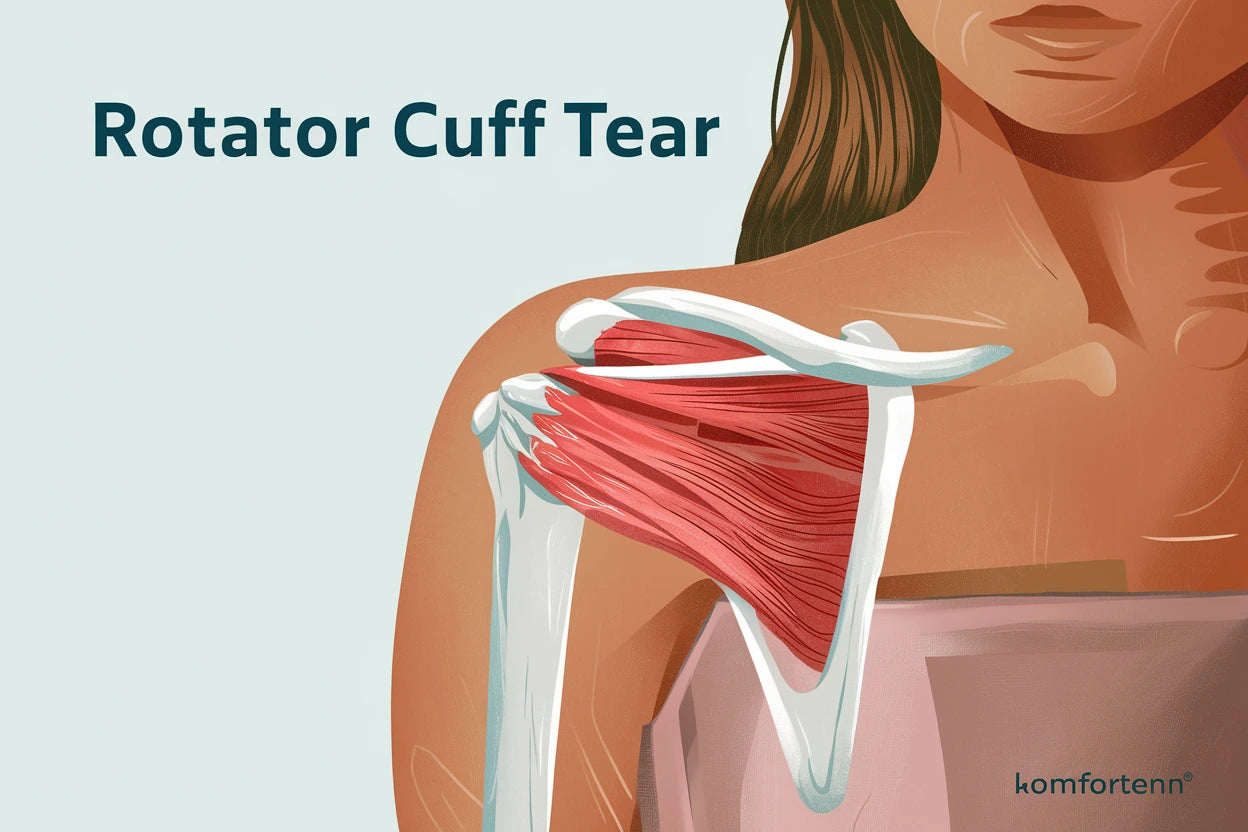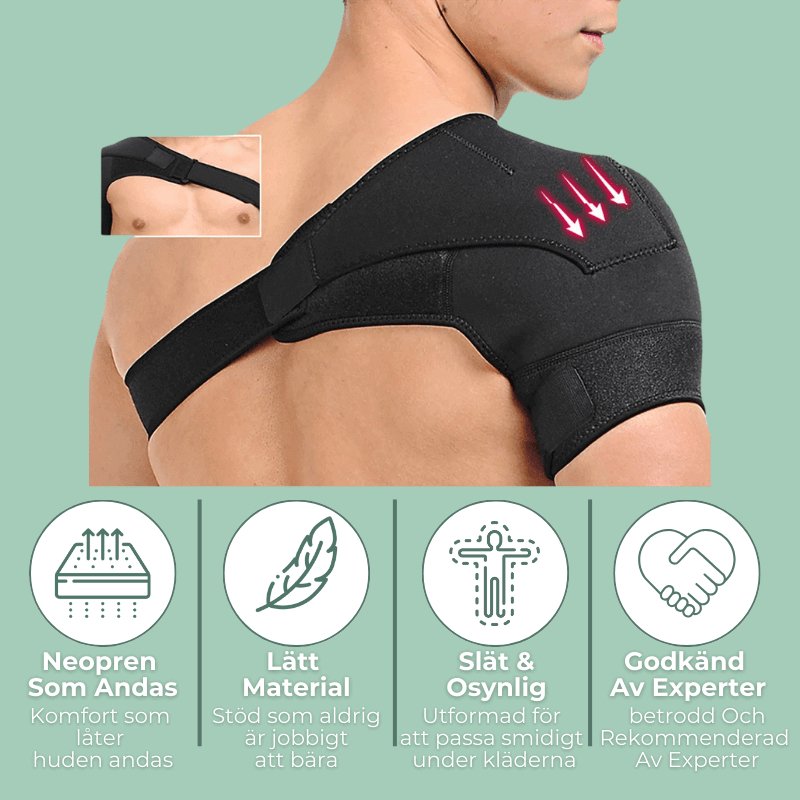Muscle Strain & Tear in the Shoulder: Symptoms, Causes & Treatment

Shoulder muscle strains are common injuries that can occur from sudden movements or overuse. These conditions can range in severity from mild strains to severe tears. This article reviews the most common symptoms, causes, and treatment options for shoulder muscle strains and muscle tears.
What is a shoulder muscle tear?
A shoulder muscle tear means that muscle fibers in the shoulder are damaged by sudden movements or overuse. This often causes sharp pain, swelling, and reduced mobility. Rest, ice therapy, and physical therapy are important for recovery.
Symptoms and signs of a muscle tear in the shoulder
Symptoms can vary depending on the extent of the injury, but common signs include:
- Sudden, sharp pain in the shoulder: This is often the first sign of a muscle strain or tear. The pain can be intense and immediate.
- Tenderness and swelling: The injured area may feel tender to the touch and swell due to inflammation.
- Limited mobility: It may be difficult or painful to move the shoulder, especially in certain directions.
- Muscle weakness: The affected muscle may feel weak or unstable, affecting the function of the arm.
- Visible or palpable changes in the muscle: In more serious ruptures, you can sometimes see or feel a depression or lump in the muscle.
- Discoloration or bruising: In some cases, the area around the injury may turn blue or discolored due to internal bleeding.
It is important to distinguish between a muscle strain and a true muscle tear, as the symptoms of a muscle tear often come on suddenly and are similar to a shoulder injury with more intense pain. While muscle soreness often develops gradually and improves within a few days, the symptoms of a muscle tear usually come on suddenly. A partial tear may involve some of the muscle fibers being damaged, while a complete tear means the entire muscle has ruptured. Symptoms usually get worse the more severe the tear.
What causes muscle tear in the shoulder? Risk factors and compression
Several factors can lead to these injuries:
- Sudden, forceful movements: Quick or unexpected movements can overload the muscles.
- Overexertion: Lifting too heavy weights or performing repetitive movements for a long time can lead to injuries.
- Poor warm-up: Not warming up properly before physical activity increases the risk of injury.
- Previous injuries: Muscles that have been previously injured are more susceptible to new injuries.
- Fatigue and exhaustion: Fatigued muscles are more prone to injury.
- Poor technique: Incorrect exercise or work technique can increase the risk of muscle strains and tears.
Certain sports, such as tennis and other racket sports, can particularly increase the risk of shoulder muscle tears due to the rapid, forceful movements required. When muscles are stretched beyond their elastic limit, muscle fibers can begin to tear, resulting in varying degrees of injury from mild stretching to complete rupture of muscle tissue . Inflammation of the shoulder can also sometimes occur as a result of overuse and contribute to an increased risk of injury.
Diagnosis and treatment of muscle strains
Fascia treatment and rehabilitation
A muscle strain occurs when muscle fibers are torn or ruptured, often due to sudden movements or overexertion. The injury causes pain, swelling, and limited mobility. A correct diagnosis and appropriate treatment are crucial for the muscle to heal properly and regain its function.
The RICE method (Rest, Ice, Compression, Elevation)
This is the basic first aid for acute muscle strains. Rest reduces the risk of aggravation, while ice and compression relieve swelling.
Advantages of AxelKomforten™ and Termoreliever™: Termoreliever™ can be used for cold therapy, while AxelKomforten™ provides stable compression and support during rest.
Pain relief
Anti-inflammatory drugs can be used to reduce pain and swelling during the acute phase.
Advantages of Termoreliever™: Can reduce the need for medication through natural pain relief with heat and cold.
Physical therapy
As the pain subsides, it is important to gradually begin movement exercises to regain strength and flexibility in the injured muscle.
Advantages of AxelKomforten™: Provides support during rehabilitation exercises and reduces stress on the injured tissue.
Gradual return to activity
A gradual increase in strain and range of motion helps prevent recurrence and ensures full recovery.
Advantages of AxelKomforten™: Provides secure support throughout the recovery process and promotes stability in movement.
Important to consider
To optimize healing and avoid scarring in the muscle, you should consult a physical therapist who can create a customized rehabilitation program.
Conservative treatment is often sufficient for minor strains, while more serious injuries may sometimes require surgical intervention.
The goal of treatment is to reduce inflammation, restore muscle function, and prevent future injuries.

Support for muscle strain: How AxelKomforten™ and Termoreliever™ relieve shoulder pain
Shoulder Comfort™ and Termoreliever™ offer several benefits for people who have suffered from muscle strains or muscle tears in the shoulder:
- ShoulderComfort™ provides support and stability to the injured shoulder, which can reduce pain and prevent further injury.
- Termoreliever™ offers both heat and cold therapy, which are important at different stages of the healing process. Cold therapy can be used initially to reduce swelling and inflammation, while heat therapy can be used later to increase blood circulation and promote healing.
- The combination of these products can help speed recovery by providing continuous support and pain relief.
- The products can be adapted to individual needs and used both during rest and light activity.
- Regular use can potentially reduce the risk of relapse by supporting proper posture and muscle balance.
- Prevention of aggravation: Keeps the shoulder in the correct position, reduces incorrect loading and relieves nerve compression in the shoulder or other problems.
Using Termoreliever™ can be particularly beneficial in improving blood circulation to the injured area, which is crucial to the healing process. AxelKomforten™ can in turn provide the necessary support needed to reduce the strain on the injured muscles while they heal, which can reduce the risk of the rupture worsening.
Summary: Effective treatment of muscle rupture in the shoulder
Shoulder muscle strains can be painful and limiting injuries, but with the right treatment and support, most people can recover well. By combining traditional treatment methods with innovative aids such as AxelKomforten™ and Termoreliever™, you can effectively manage symptoms and promote healing. It is important to listen to your body's signals, give the injury time to heal and gradually return to normal activity to avoid relapse. With innovative aids such as AxelKomforten™ and Termoreliever™ and proper rehabilitation, the risk of long-term problems such as osteoarthritis in the shoulder is reduced.
Early intervention and proper treatment are key to optimizing the healing process and minimizing the long-term consequences of muscle strains. By following recommended treatment guidelines and giving the body enough time to heal, most people can return to their normal activities without lasting damage.
Frequently Asked Questions (FAQ)
How long does it take to recover from a muscle tear in the shoulder?
Recovery time varies depending on the severity of the injury, but can take anywhere from a few days to several weeks. Mild strains often heal within 1-2 weeks, while more serious injuries may take longer.
Can I exercise with a muscle tear in my shoulder?
It is important to give the injury time to heal. Light exercise and specific rehabilitation exercises can often be started after the acute phase, but always consult a physiotherapist or doctor first.
How do I use Termoreliever™ for an acute muscle strain?
For an acute injury, use cold therapy for 15-20 minutes at a time, several times a day for the first 48-72 hours. After that, you can transition to heat therapy to promote healing and increase blood circulation.
Can AxelKomforten™ prevent muscle tears in the shoulder?
Yes, by providing support and improving posture, AxelKomforten™ can help reduce the risk of overuse and injury. It is especially useful during activities that involve repetitive stress on the shoulder.
When should I seek medical attention for a muscle tear in my shoulder?
Seek medical attention if the pain is intense, if you have significant swelling or discoloration, if you cannot move your shoulder at all, or if symptoms do not improve after a few days of self-care.

